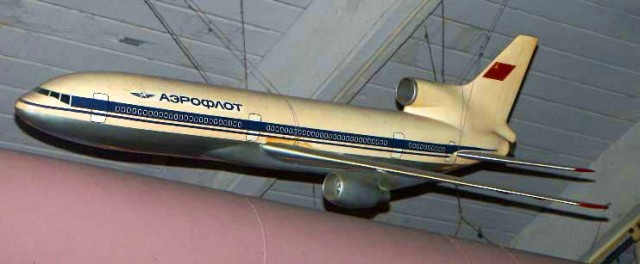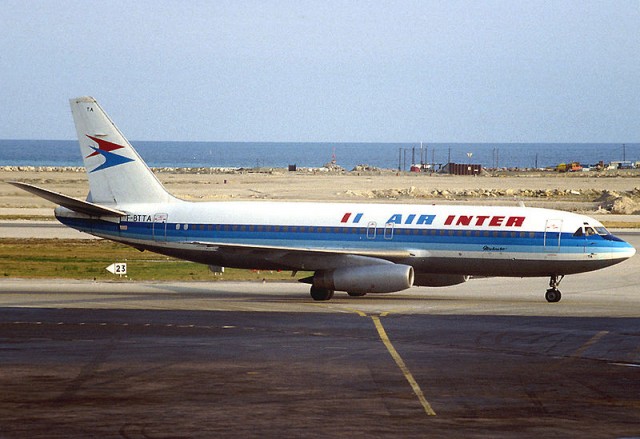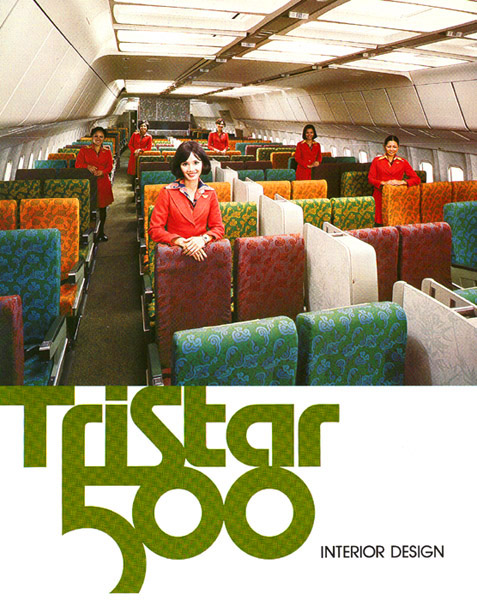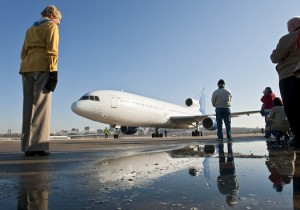
I bet most people thought this was a joke! Photo: Chris Sloan | Airchive.com
The 1970s were a time of economic malaise for the west. Weirdly, the Soviet Union was chugging along at its own egregious and bizarre pace, and Soviet air travel needs had never been more pressing. Millions of Warsaw Pact and Soviet citizens needed to shuttle around the Iron living room. In fact, Aeroflot celebrated its hundred-millionth-passenger year in 1976. This called for larger aircraft. Engine technology issues were holding up Ilyushin’s domestic design, which we now know as the mostly-extinct IL-86.
The program to which the IL-86 stemmed from was formally known as the “aerobus”. The IL-86 was not supposed to be the only aircraft of the family of short, medium, and long-haul indigenous widebody aircraft.

Believe it or not, Tupolev almost built a similar aircraft (but widebody) to the Dassault Mercure. Photo: Alain Durand
Tupolev had stepped up to offer the Tu-184, an aircraft that was similar to a twin-aisle Dassault Mercure. Thankfully, at the time of its inception Andre Tupolev was still alive. He took one look at it and decided that the company should not waste any resources on what he was sure would be nothing but a reputation-wrecking disaster. Not that Tupolev was immune to civil aviation failures, they are simply beyond the scope of this article. They were also, usually, swept under the rug and blamed on Myashischev (a competing design bureau).
![From the EAL publication "Pastimes" from 1972. The centerfold introducing the L-1011 to the EAL fleet. Notice the First Class (red seat) arrangement..nice. Image from David Capodilupo. [CLICK FOR LARGER]](https://www.airlinereporter.com/wp-content/uploads/2013/01/L1011-640x441.jpg)
From the EAL publication “Pastimes” from 1972. The centerfold introducing the L-1011 to the EAL fleet. Image from David Capodilupo. [CLICK FOR LARGER]
Eastern was one of two co-launch customers for the L1011 (TWA was the second), which started service in 1972 with the airline.

Eastern Air Lines Lockheed L1011. Photo by Bob Garrard.
The spacious layout, the luxurious amenities — the way flying used to be right? Also remember that there were fewer flight options, limited in-flight entertainment, louder, less safe and cost much more. Yes, things have changed, but I think mostly for the good. Doesn’t mean I don’t miss the L1011 and EAL.

Image from Chris Sloan / Airchive.com.
The image above is from the L1011 Sales Brochure, this shows a more cramped 2-4-3 layout for economy (the cut-away above shows a 2-4-2). Check out those center dividers and the lack of center overhead bins.
SOME ADDITIONAL L1011 GOODIES:
* Sales brochure for the Lockheed L1011 in 1979 via Airchive.com
* More classic Eastern Air Lines L1011 Photos by Bob Garrard
 |
This story written by…David Parker Brown, Editor & Founder.
David started AirlineReporter.com in the summer of 2008, but has had a passion for aviation since he was a kid. Born and raised in the Seattle area (where he is currently based) has surely had an influence and he couldn’t imagine living anywhere else in the world.
@AirlineReporter | Flickr | YouTube |

Jeanne Grauberger, who was a TWA flight attendant from 1956 to 1962, was among those at the Lockheed L-1011 touched down.
Most airline enthusiasts have a special place in their hearts for the Lockheed L1011 Tristar. There aren’t too many airborne around the world today. You might be able to catch the Sand’s L1011 that they flight high rollers to and from Las Vegas or you could have been in Kansas City, Missouri on Saturday. That is where one L1011, that started life at TWA, made its last flight to the Airline History Museum.
At first it looked like “Elle” (the name of the L1011) was heading to the scrap heap. A generous donation by Paul Pristo helped to not only save Elle from being destroyed, but also making her airworthy to do the flight from the desert in Roswell, New Mexico to the museum in Missouri.
Originally the flight was supposed to occur back in April, but the FAA put a stop to the flight due to serious safety concerns. To get approval from the FAA, Elle had to satisfy 28 airworthiness directives. The L1011 had a complex history, starting life in the US, but also flew in Africa and South America, where maintenance rules are more lax. There was also concern about the rear wing spar having cracks, which is a common issue for these large planes. Planes that were flying in the US had modifications done, but since Elle was out of country she did not. Luckily there were no signs of cracking and after $60,000 of mechanical upgrades, she was ready to make the journey.
On Saturday, Elle was ready to go and so were her fans. The flight crew has stayed certified on the L1011 by training on a surviving simulator owned by Delta Air Lines in Atlanta. Because of the age and potential issues, the FAA required only essential personal be on the plane, it wasn’t fully pressurized, and it must fly lower and slower than normal.
The flight on Saturday went perfect. It was exciting for the guest gathered to see this wonderful airplane fly once again. Elle will be turned into a classroom for children to come to the museum to learn about airlines and flight. It seems like she has found a wonderful new home.
Thank you @user47 for the tip!
Additional Information:
* More pictures from KansasCity.com
* Videos from Airline History Museum
* 37 photos of Elle’s history on Airliners.net
Image: John Sleezer via KansasCity.com


![From the EAL publication "Pastimes" from 1972. The centerfold introducing the L-1011 to the EAL fleet. Notice the First Class (red seat) arrangement..nice. Image from David Capodilupo. [CLICK FOR LARGER]](https://www.airlinereporter.com/wp-content/uploads/2013/01/L1011-640x441.jpg)



